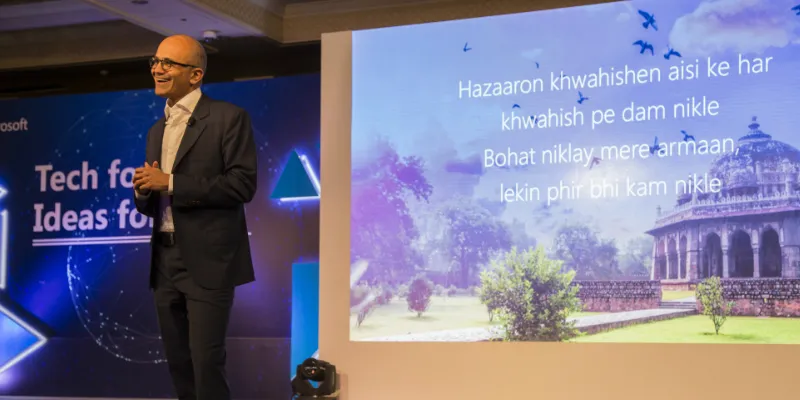How Satya Nadella aims to fulfill his 'hazaaron khwahishen' of empowering India
Microsoft CEO Satya Nadella is currently in India on his third visit after taking over the reins of the software giant from his predecessor, Steve Ballmer, in February 2014. Earlier today, Satya spoke at 'Tech for Good, Ideas for India', an initiative of Microsoft India's to engage with young achievers to see how technology can foster a culture of innovation.
Onstage at the event, Satya noted that there had been two passions that have been driving factors and catalysts to his dreams- poetry and computer science. To relate the two in the context of his dreams to help 'Empower India', he quoted poet Mirza Ghalib's 'Hazaaron Khwahishen Aisi (A thousand desires such)'.

Hazaaron khwahishen aisi ho ke har khwahish pe dam nikle
Bohat niklay mere armaan, lekin phir bhi kam nikle
The quote in English loosely translates to
Thousands of desires, each worth dying for...
many of them I have realised...yet I yearn for more...
Satya noted that his interpretation of Galib’s saying changes every year. He said, "I learn something new, there are so many layers and labyrinths in there that every time I feel like I’ve learnt it again."
On the current state of the global and Indian technology ecosystem, Satya said he found the level of intelligence that we are going after and infusing into, for all industries, to be stunning. He spoke about the importance of infusing cognitive technology into any app or service and about celebrating the technology that India creates. He said,
"You are going to have apps that recognise natural language and text, and the ability to bring cognition into the application experiences and then augment, in fact, human capability. It is a pretty phenomenal time to be a developer."
Satya said that going forward there will be a profound shift in how computing is being experienced by everybody and believed that bots understanding human language will lead the change. We will enter a new age where 'conversations-as-a-platform' will be the centre of the human-technology interaction. He said,
"Just like how you built websites and mobile apps in the past, you are going to build these bot interfaces that understand human dialogue."
Augmented reality

The other innovation that Satya was 'blown away' by was mixed reality and augmented reality (AR). With Hololens, Microsoft is entering the AR/virtual reality (VR) space. He said that with computers humans have created these mirror works, where something in the physical world is taken to create digital metaphors.
"But now for the first time in our history, we are able to take what is our field of view and turn that into an infinite display. Just imagine, in what you see, you not only see the analog world but you can in fact, see the digital world along with it," he quipped.
Where India comes in
In a press note, Microsoft noted that India is at the cusp of a digital revolution that's fundamentally changing the way we live, work and interact with one another. It said,
"As a billion people get connected through mobile devices - the possibilities are endless. This coupled with emerging technologies like machine learning, Internet of Things (IoT), robotics and 3D printing will pave the way for India to be at the forefront of the fourth industrial revolution."
The note added that as a country with a billion empowered citizens, the possibilities for India are inspiring, exciting and endless. So in the theme with 'Empower India' the tech giant shared two initiatives that have surfaced as part of the company's efforts.
Spot Garbage
Spot Garbage, developed by a trio from IIT Ropar, is a real-time garbage management system using machine learning and computer vision to identify and segregate garbage imagery. They have won the India-round of the Imagine Cup, a global student technology competition that aims to recognise and nurture budding technologists and will represent India at the global finals shortly.
Lifesaver app
The Lifesaver is an app created by Kshitij, a student of IIT Jodhpur. It uses data feeds like heart rate, exercise patterns, calories burnt and sleep quality and converts it into actionable recommendations. It claims to be sensitive to the symptoms of a heart attack and can detect and alert users, and their contacts, about an imminent heart attack. Kshitij had always nursed a desire to solve a social problem, but he was just another youth with dreams and no backing, until he enrolled in the Microsoft Academia Accelerator programme, which is aimed at building a deep, long-term association between Microsoft and the academic community.
Other developments
Through this, and other initiatives like YouthSpark, The Imagine Cup, Academy Accelerator programme, Microsoft India aims to work with the youth of India to solve real-world problems and drive India's transformation.
Satya also interacted with Ravi Shankar Prasad, Union Minister holding the Communications and Information Technology portfolio, and discussed about enhancing cooperation with Microsoft towards the Government's Digital India initiative.
On his last visit to India last December, Satya had met Andhra Pradesh Chief Minister N Chandrababu Naidu and visited the campus of startup incubator T-hub and the Microsoft development centre in Hyderabad. In November, he had delivered a keynote address at Microsoft’s ‘Future Unleashed’ event in Mumbai and met industry leaders like Mahindra Group Chairman Anand Mahindra and Axis Bank Managing Director Shikha Sharma.
It will be interesting to see other developments unfold and observe what else is on Satya's agenda during a visit that closely follows that of Apple CEO Tim Cook's, which saw a lot of interesting developments and announcements.
Related read from May 2016: Find out how T hub and Microsoft are digitally unlocking the agriculture issues of the country
Related read: After Google and Facebook, it’s Microsoft’s turn to provide affordable internet access







